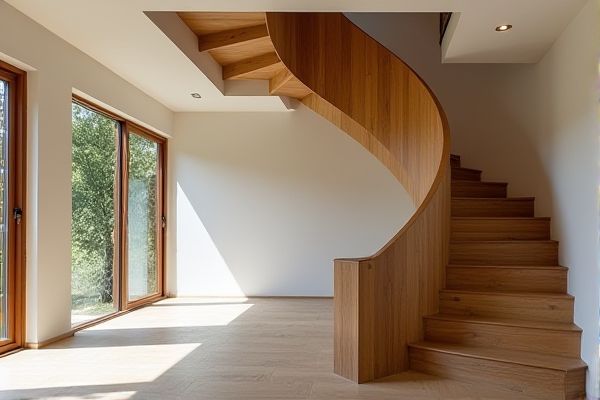
Helical stairs feature a smooth, continuous spiral without a central pole, offering an elegant and modern aesthetic, while winder stairs consist of straight steps that turn at a landing, saving space in tight layouts. Understanding these differences can help you choose the ideal staircase design for your space; explore the article to find out which option suits your needs best.
Table of Comparison
| Feature | Helical Stair | Winder Stair |
|---|---|---|
| Shape | Continuous spiral with no central support | Turns with triangular or pie-shaped steps at corners |
| Space Efficiency | Compact, ideal for tight spaces | Moderate, requires more space at turns |
| Construction Complexity | High - requires precise engineering and materials | Medium - simpler than helical stairs |
| Aesthetic Appeal | Modern, elegant curved design | Traditional, functional design |
| Cost | Higher due to design complexity | Lower and cost-effective |
| Safety | Good with proper railing, but narrower steps | Safer due to wider landing steps |
| Common Use | Residential, commercial, luxury spaces | Residential, space-saving staircases |
Introduction to Helical and Winder Stairs
Helical stairs feature a smooth, continuous spiral without a central pole, creating a modern, open aesthetic and efficient use of vertical space. Winder stairs consist of triangular-shaped steps that turn corners, allowing for compact designs ideal in confined areas. Both stair types optimize floor space, with helical stairs emphasizing fluid motion and winders focusing on angular transitions.
Defining Helical Stairs
Helical stairs are characterized by a smooth, continuous spiral design without a central pole, offering a graceful and modern aesthetic ideal for maximizing vertical space in compact areas. Unlike winder stairs, which change direction through triangular steps at corners, helical stairs maintain a consistent curved shape, providing safer and more comfortable navigation. The engineering of helical stairs involves precise calculations for radius, rise, and run to ensure structural integrity and ergonomic comfort.
Understanding Winder Stairs
Winder stairs feature triangular or pie-shaped treads that turn corners without a landing, optimizing space in tight areas. Unlike helical stairs with continuous curved steps, winder stairs provide efficient directional changes while maintaining a compact footprint. Their design is ideal for maximizing usable floor area in residential and small commercial buildings.
Key Design Differences
Helical stairs feature a smooth, continuous spiral without a central pole, creating a visually open and elegant design, while winder stairs incorporate triangular steps that change direction, often used to save space in a corner configuration. The helical stair's curved stringers and constant radius contrast with the angular turns and varying step shapes in winder stairs. Structural complexity and installation methods differ significantly, as helical stairs require precise engineering for curved components, whereas winder stairs typically follow traditional straight staircase framing with angled flights.
Space Utilization and Footprint
Helical stairs offer a compact footprint with smooth, continuous curves that maximize vertical space, making them ideal for tight areas or architectural designs emphasizing flow and elegance. Winder stairs use triangular steps to change direction without requiring landings, often saving floor space compared to traditional straight stairs but typically occupying more room than helical designs. Choosing between the two depends on your specific spatial constraints and aesthetic preferences, with helical stairs providing superior space utilization through their spiral form.
Aesthetic Appeal and Style
Helical stairs showcase a sleek, modern aesthetic with their smooth, continuous curved design and open central void, creating an elegant focal point in contemporary spaces. Winder stairs offer a traditional and space-saving style, featuring triangular treads that create a compact turning point, often enhancing classic or rustic interiors. The choice between helical and winder stairs significantly impacts the visual flow and architectural character of a home or building.
Construction Complexity
Helical stairs feature a continuous curved design that requires precise engineering and custom fabrication, resulting in higher construction complexity compared to winder stairs. Winder stairs are built using triangular-shaped steps that simplify the turning of a staircase within a confined space, making their construction more straightforward and cost-effective. Your choice between these stair types will impact construction time and budget due to the varying levels of precision and materials involved.
Safety and Building Codes
Helical stairs provide enhanced safety due to their uniform tread width and consistent curvature, reducing trip hazards compared to winder stairs, which have varying tread sizes that can increase the risk of missteps. Building codes often favor helical stairs because they comply more easily with regulations on stair width, handrail continuity, and tread depth, ensuring safer navigation. When selecting between the two, consider how your stair design aligns with local safety standards to protect users and meet code requirements effectively.
Cost Comparison
Helical stairs typically cost more than winder stairs due to their complex design, custom fabrication, and installation requirements. Winder stairs offer a more budget-friendly solution by utilizing standard materials and simpler construction methods. Your choice impacts both upfront expenses and long-term value, with helical stairs often serving as a premium architectural feature.
Choosing the Right Staircase for Your Space
Helical stairs, characterized by their smooth, curved design without central support, save space while offering a modern aesthetic, ideal for open areas with room to showcase their elegance. Winder stairs, with triangular treads turning corners and requiring less floor space than traditional straight stairs, provide a practical solution for compact or irregularly shaped spaces. Your choice between helical and winder stairs depends on balancing spatial constraints, style preference, and the staircase's impact as a design feature in your home or building.
 homyna.com
homyna.com